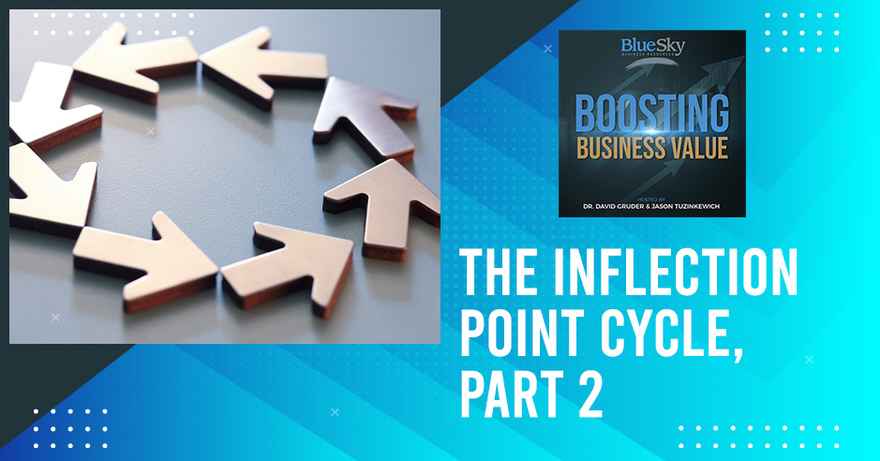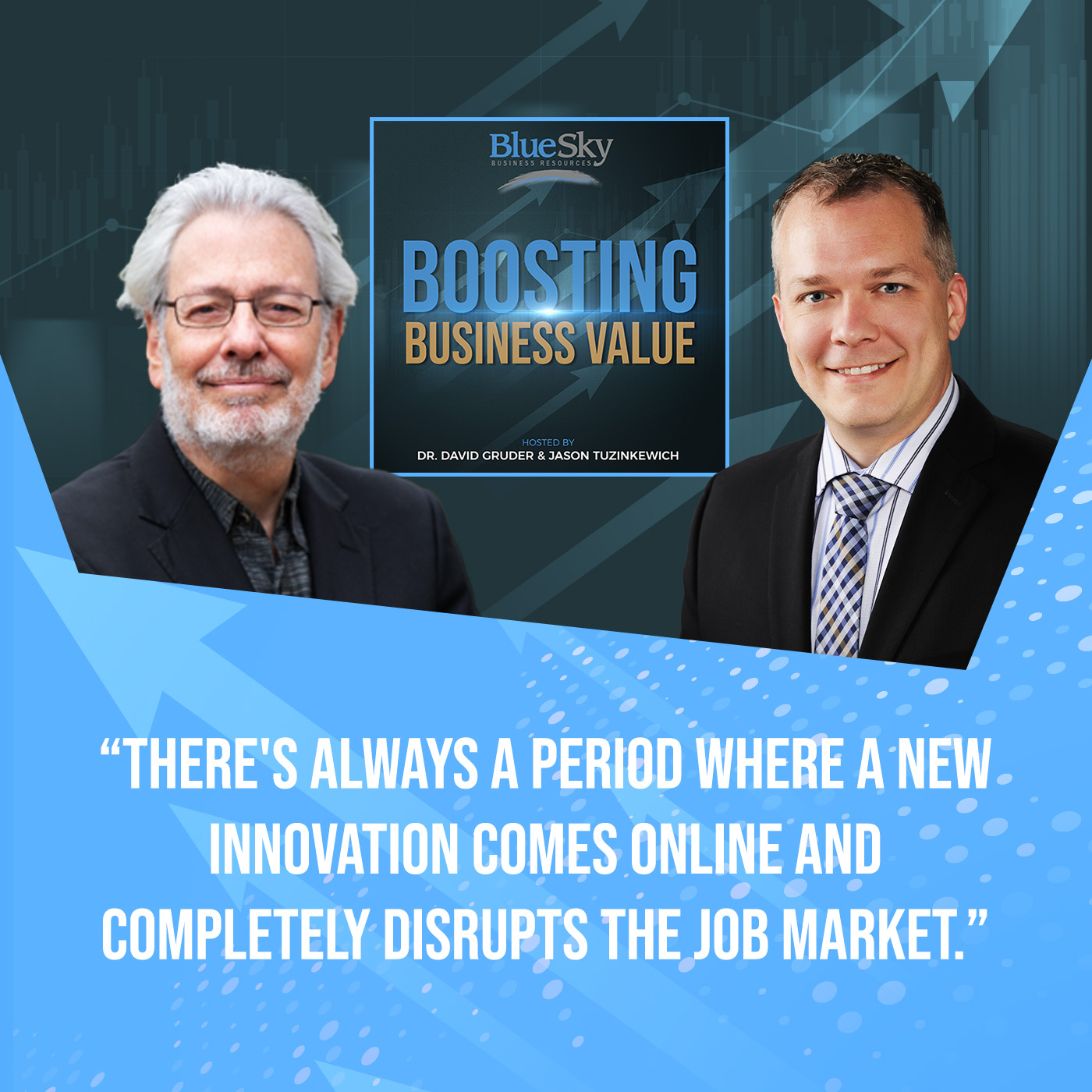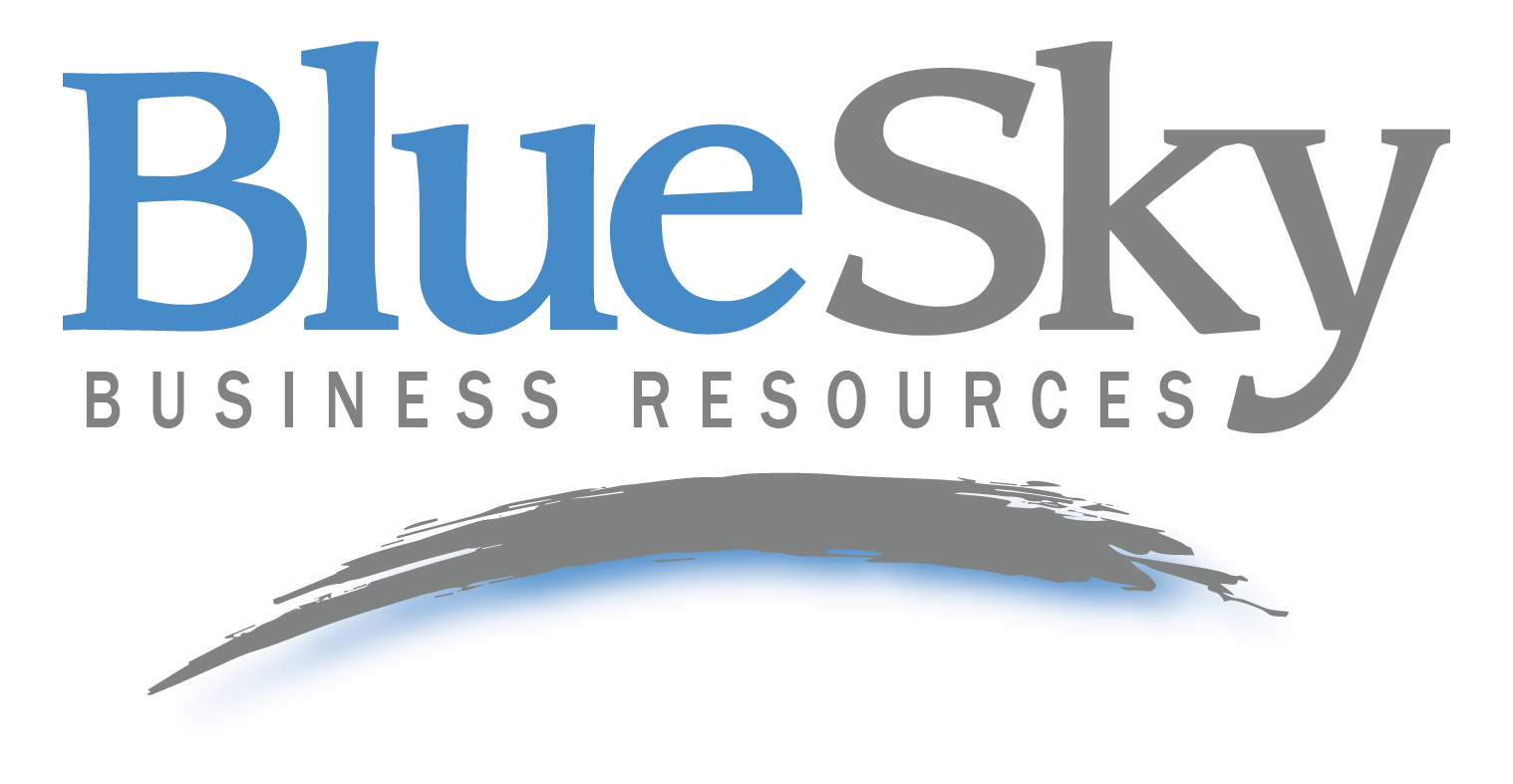Ep. 26 - The Inflection Point Cycle, Part 2

Innovation is the compass that guides businesses through uncharted waters, where creativity and adaptability become their greatest assets on the journey to lasting success. In the second part of our four-episode mini-series, "The Inflection Point Cycle," we uncover the strategies essential for mastering the critical moments every business faces: Innovation, Fruition, and Bifurcation. In this episode, we will be focusing on the business’s first inflection point: the Innovation Phase. With hosts Dr. David Gruder and Jason Tuzinkewich, this discussion explores the unique dynamics of innovation in startups and established businesses. They explore the significance of cross-functional productivity, the importance of resource maximization, and more. In the dynamic world of business, embracing innovation is the key to growth and sustainability. Tune in now to gain a competitive edge, drive profitability, and create lasting value in your entrepreneurial journey.
---
Watch the episode here
Listen to the podcast here
The Inflection Point Cycle, Part 2
Successfully Navigating Your Business's First Inflection Point: The Innovation Phase
This episode is part two of our current mini-series on the three inflection points that all businesses must master to achieve durability and long-term growth. In this episode, we're going to dive into the first inflection-point-related information, which is about the innovation phase. For those of you who are new to this Boosting Business Value show, and why should you be new, you've probably been binging on all of our prior episodes for crying out loud, I'm David Gruder, the Business Lifecycle Exit Planning and Post-Acquisition Psychologist for Blue Sky Business Resources. With me, as always, is my trusty foil sidekick and thought leader of many capacities, Jason Tuzinkewich who is Blue Sky's Chief Operating Officer. Take it away, Jason.
It's great to be with you again. I mentioned this in part one, but I'm so excited about this series because this is some important stuff. We're going to dig pretty deeply into innovation in this episode. First, let's back up a little bit. Let's talk about what we mean when we say these inflection points that business owners and their teams need to master and what specifically those inflection points are. The way that we're talking about it right now is that inflection points are major functional pivot points. This is a time where if you're looking at it on a plot, the graph goes from pretty flat to straight up. This is where strategy organization tactics and leadership style requirements must change in order to succeed at what's next. It's a perpetual cycle.
In durable businesses, there are these three points that you keep encountering over and over again in your life. That's why it's so important to master them. What are these three? We already mentioned innovation. This is where things start. We then go to fruition. This is where things grow, expand, and penetrate markets. You then get to bifurcation. Bifurcation, to quote the term by one of my professors, Dr. Tushman, is when the business has to become ambidextrous. It's when it's doing both innovation and fruition simultaneously, which are the most cumbersome, the most troubling point for business owners, and where a lot of businesses fail and languish. We're going to talk about all three of these in this mini-series. Let's kick off this innovation phase. Let's get the business started.
Let's do it. What happens during the innovation stage? It's probably pretty obvious that in this phase of innovation, we're creating something new that the market wants. That might be a need or a capacity to fill a need. There's something new that has emerged that is a need that hasn't existed so much in the marketplace up until now, and where your business has the capacity to fill that need in some form. That's one thing that the market might want in the way of something new.
It's so exciting that we're in a time where technology is advancing so quickly that these new needs and these brand-new market potentials are coming at us at a rapid pace. There's always an opportunity to do that. The other one is when the need exists, but the market is unmet. Our businesses or whoever the buyer is are not finding what they're seeking. They know that there's a need. The need has existed for a while, but there hasn't been a product or a service delivered that satisfies that need.
Another situation that calls for innovation is where the need exists, and it's been filled in some manner up until now, but the marketplace or the buyers now need a next evolution beyond what is already available to them.
Piggybacking on that, a lot of times this happens when an industry grows and starts tapping into that newly created capacity. Now, the needs that they've had met by some product or service need to be specialized to service their new performance goals. It's that evolution, but it's narrowing the focus into something that is tailored or bespoke to these newly emerging needs.
Not just newly emerging needs, but specialized versions of what's already available that have been customized for a specific sub-niche of a specific marketplace rather than a generic version. Where there is an existing need, it's being met pretty well, yet a new sub-need emerges where buyers want that product or service delivered in a different way than it's currently available.
I use Microsoft Office all the time and I used to use it on my PC, but now I want to use it on my tablet, on my laptop, and on different operating systems. You see this all the time in a lot of different products and services where the delivery method changes over time. There's a lot of room for innovation in there. The last one, as we always talk about with businesses, we talk about how businesses compete. They compete on timing, on price, and on quality. You can only ever do two.
The one thing that we haven't talked about in innovation, but that is crucial is getting to that point where you can compete on price, where you can deliver a fundamentally different price point in some way, shape, or form to satisfy the existing need. That's another innovation that in many ways has disrupted a lot of our markets recently.

It's going to disrupt our markets even more in the coming years as robotics starts to take over certain repetitive tasks that up until now, humans have done. When that happens, there will probably be different price points for those same products. With any luck at all, the price points will be lower, and the people who used to do those jobs will hopefully be retrained by the company to fill other roles that will be available for them to fill because they're not doing that kind of grunt work that robots can do.
I love your optimism. Let's see that happen.
It is an optimistic viewpoint. I'm not saying it will happen that way. I'm saying I want it to happen that way.
I'm along with you. With our experts in business and advisory that tune in to this show, we can generate a community that can ensure that can happen. It's feasible to retrain, replace, and upskill your employee staff so that you don't have to go find new employees as technology changes the demand from a production focus to a creative thought and problem-solving focus.
The footnote that I want to add there because it feels important to me to insert is that this has always been true in the business world. There's always a period where a new innovation comes online and it completely disrupts the job market. What's available in the job market when certain jobs vanish, new jobs emerge. That is always occurring in each evolution in the marketplace. What we're talking about here, specifically with AI and robotics, is happening now. The basic dynamics we're talking about have always happened and will always continue to happen. If you're getting wigged out by that, what's more important is to ask yourself what's your next evolution in your capacities to fill certain roles and certain jobs as needs change in a business.

We stepped a little bit off the beaten path and onto a little bit of a soapbox here, but I do want to add one more thing to this because this is important stuff. It's also historically proven and true to this day that as technology improves and makes certain tasks and job titles obsolete, more job titles emerge. The increase in automation and robotics has created a lot more job titles in technical thought, design, programming, and process management. It’s all of those things, then it took away in frontline production. As long as we keep that in mind and we recognize and we look for the growth areas, then it's easier to determine how to retrain people and make them fit.
Don't listen to the doomsayers who are saying, "The sky is falling around this." The sky is not falling. It's always the marketplace. The business world has always evolved in ways where jobs that used to exist cease to exist, and new jobs that never existed come on board and are needed. People need to fill those new jobs.
That was a fun little side trip.
It was, and a really important one. We could probably devote a whole episode to that, but that's something to consider for another time. In the innovation phase, the thing that's built into innovation is that by definition, it is a phase that has high loss and high burn rate. What you are innovating hasn't been monetized yet. It hasn't been brought to the market. It's not generating revenue, let alone profits because you are developing it.
By definition, the innovation phase is a phase where you are going to have a burn rate. You're going to be losing money. If you're an existing business, you're going to be funneling a portion of your profits into something new that's not yet monetizing. We're going to return to that as we unpack this a little bit further because the fact that that so requires a certain kind of vetting before jumping in with both feet with a new innovation.
To build on to that, everything about this phase is dynamic. It's in high flux. You look at this juxtaposed against the fruition phase where it's all about streamlining, systematizing, and making continuity and consistency. This is the exact opposite of that. You are changing that concept of failing forward, and failing forward fast is tantamount to success in the innovation phase. You've got to fail fast because you've got to quit pursuing things that aren't going to work. Your failures have to move you forward to getting to that product that you can monetize and sell.
Not only is the design process dynamic. The communication process and the resource allocation process, all of these things are changing throughout. If you think about the two major long-term functional phases of a business, the innovation and the fruition phase, innovation is all about rapid dynamics. A lot of change, a lot of turnovers, always being flexible, and being able to pivot quickly. Whereas the fruition phase, as we'll talk about in the next episode, is all about not pivoting and not changing. You can optimize, but you're not going to make major fundamental changes in communication structure, positional responsibilities, or the product itself.
Well said. The punchline from that is that even in an existing business when an existing business moves into a new innovation phase, they have to think like a startup. They have to think like early-stage entrepreneurs. There's actually a term for that in the business world. It's called being an intrapreneur rather than an entrepreneur. Where you are bringing entrepreneurial mindsets and innovative mindsets that are part of the startup mindset into an existing business during an innovation phase. It calls for entrepreneurship in an existing company.
Of course, because of the nature of what innovation requires, while you're innovating, there's going to be all kinds of cross-functionality and matrix communication. All of those are essential. The important thing is that the way that an innovation team operates always supersedes hierarchical structures in the main business if it's an existing business that's going into its next innovation phase. The innovation team cannot be constricted by the status quo hierarchical structures inside of the innovation team. Obviously, they have to interface with the executive team and the existing hierarchical structures, but that's external to the innovation group. Inside the innovation group, all bets are off. Chaos in a positive sense of chaos is not only welcome, it is necessary.
I like that structured chaos concept. All bets are off to a point as long as they're failing forward and as long as they're driving towards something that's monetizable. There do need to still be some guardrails on here, but they're a lot wider than they are in the normal operation of an existing mature business.
It occurs to me to have you add something. I think cross-functionality is going to be clear to our audience. For our audience who aren't familiar with the term matrix communication, can you define that?
If you think about a business and you think about the way that you in your business communicate with your team. Typically, the specific functional team communicates among themselves. Engineers talk with engineers. Sales and marketing people talk with sales and marketing people. Sometimes the sales and the marketing people don't even communicate that much. It's almost siloed. You talk within your teams horizontally, and you talk vertically to your higher-ups and to the people you require things from further down the process chain.
In matrix communication, you need the inclusion of a sales and marketing person. You need the inclusion of an engineer. You need the inclusion of somebody on the plant floor because all of their input is critical. What you can design that you love is great for you, but if you can't sell it, or the sales and marketing team recognizes that there's not a market for what you're building, then don't make it. If the marketing team is there and they have a voice at the table, then they can maybe say, "There's not a market for that product in this. If you made these tweaks and changed this functionality, we know there's a huge market horizontal to it.”
Having that ability to communicate directly across all the silos and divisions is what matrix communication is all about. In order to do it effectively, there needs to be a point of contact in each place. Those lines of contact need to be clearly defined so that you're maintaining a clear flow of knowledge and transparency, but also not redoubling effort or getting conflicting orders.

Let me use a quick analogy to drive this home. There is traditionally a competitive attitude and disdainful attitude that architects and builders have toward each other. Architects are creating a design that a builder's going to build. When an architect is in the brainstorming phase, in the initial parts of innovation, it would be premature for them to be talking to builders. Once they've got a clear sense of what their creativity is giving birth to. If they don't go to the builders to find out what is and isn't actually implementable in their brilliant creative process, then they'll end up with an architectural design that falls into a category that I call true but not useful. It may be true in terms of creativity, but it's not buildable. It's not useful.
This is a metaphor for what is often missing during the innovation phase in any business. At some point in the creative process, you've got to go to the salespeople to see if this is sellable. You've got to go to the production people and the delivery people to see if this is deliverable. If it's not in the form you've initially brainstormed, then what tweaks will you have to make so that what you are innovating can actually be profitized?
I love your analogy because I was at a parade of homes, and I walked through this house that was gorgeous. Beautiful layout. Everything was very nice, except there were six thresholds in the building. In one house, six thresholds where they couldn't mount doors because they didn't work. They didn't fit. I'm like, "You have such a nice house, but two of those thresholds were on one bathroom." There was one bathroom that had two doorways that couldn't have doors on them. That's the exact failure of matrix communication.
It's a beautiful example. Unfortunately, one of our nieces is an architect with a builder's mindset. One of my longtime friends and colleagues is a builder with an architect's mindset. It's that cross-fertilization that makes projects successful.
They work together like peanut butter and jelly. Moving on. Let's touch briefly on some things. We're not going to belabor this strictly because the next episode will drive these points home, but let's spend a couple of seconds on what doesn't happen during the innovation phase. Things that are specifically excluded from innovation phase success.
The first one of those is managing margins. This comes up because the innovation phase is something you have to keep going into. When you're a startup, it makes perfect sense. When you're a startup, it's obvious you're not driving margins until you can sell a product. It's when you're in a going concern that is shifting into that bifurcation phase where it's innovating and running a business where managing margins becomes part of the mindset that carries over and should not.
The innovation phase is something you have to keep going into.
The other thing that doesn't happen during the innovation phase is production optimization. At some point in the innovation process, you're going to be consulting with the people who will be responsible for producing what you're innovating after you've done your initial brainstorming, envisioning, and all of that juicy initial creativity.
You'll consult with them, but you're not in the innovation phase focused at all on production optimization. You're not optimizing the product or service that you're innovating yet. You might be optimizing the product or service that you're going to be bringing to the market, but what you're not optimizing is how it's going to get produced, how it's going to get sold, how it's going to get marketed, and how it's going to be delivered. That's for the next phase. That's not for the innovation phase.
I'm so glad you brought that up. Thank you.
Big challenges and solutions for navigating the innovation phase. Let's touch first on innovation, inflection points, challenges, and navigation. You've already mentioned one of those huge challenges and solutions, which is when you're in the innovation phase, you've got to set aside status quo addiction, the way we've always done things, and all of that mindset, and replace it with the capacity to creatively fail forward, just like you mentioned earlier, Jason.
Thank you for that. This capacity is twofold. The individual who's innovating at any given point in this process has to be able to be wrong. The rest of the team, the innovation team, as well as the leadership team guiding this, has to be able to not punish when people are wrong. The mistakes need to be a, "Yes, that didn't work. What did we learn?" versus, "That didn't work, it costs us this much. What are you doing?" That's a big issue. I'm glad you put that at the forefront.
The other thing, it's piggybacking on this. We're saying, you have to be able to make mistakes. You have to be able to throw something away if it's not working. You also have to maximize limited resources. You're not going to have the full bank account of a going concern. If you're a startup, you've got what you've got in your bank account. Maybe a couple of investors, but you have to prove something before you can get big investors. You also don't have the manpower. With a startup, you have to build your team. You don't have a lot of money to pay. Who's going to buy into this vision and jump on board for limited trust in the success that comes, and then your limited resources of infrastructure, equipment, and all of those things?
You have to be able to make mistakes. You have to be able to throw something away if it's not working, but you also have to maximize limited resources.
You're either starting from a clean sheet or from a smaller swimming pool than a business that's in fruition. The ability to make the most out of every single dollar, every single person, and every single piece of equipment and technology that you have is crucial in this phase because there's no revenue coming in to support your losses.
That's right. There's only the amount of money that you've allocated for the innovation. Another challenge and solution is focus, as we've already said. I'm not going to belabor this. On extreme cross-functionality, siloing has no place during innovation. The sky is the limit. What about blank? What if blank? Not as a way of putting down a new idea or a new innovation, but as a way of fleshing out that potential innovation to do viability vetting. I'm a real fan of blue-skying without those kinds of what-ifs.
Me too.
Also, I'm a fan of recognizing when you have been creative to the point where you now need to vet the viability of the thing that you are imagining. You're exercising your creative juices to brainstorm into potential existence. Does it deserve to come into potential existence? That's why cross-functionality is so important because the ability to think through different lenses and through wearing different hats in looking at the viability of what you're innovating is crucial.
It has to work and it has to be producible. It has to have a market, and it has to be able to be made for a profit. At the end of the day, when you've got a great idea, it has to be proven against those four things. Ideally, you'll have a scope of work that will put the sandbox around those four things in the beginning so that you're not just throwing darts with a blindfold on.
Agreed.
The most critical element to success in all of this before you create your cross-functionality, before you start working on matrix communication, or even allocating any money, is that there must be a clear and inspiring vision that the innovation team and the executive team have bought into. It'd be great if the whole team buys into it, but at the very least, the functional innovation team and the leadership team that holds the purse strings have to buy into this clear inspiring vision. Without the inspiration, your team's going to burn out and the executive team will lose interest, which means you'll lose funding. Without clarity, you won't be able to prove success and you won't have a rudder to guide you in the right direction. It has to be both.

Well said and very important. That is utterly mandatory. What we're going to do in the final part of this show before we move into takeaways and closing is we want to unpack the specifics of the two different types of innovation cycles that can occur. The first is innovation for the first time around, meaning in a startup. There's the startup innovation phase, and then there is the innovation phase inside an existing business. We'll start with innovation in startups.
We've talked about a lot of these points that we're going to discuss because many of them overlap, but they have different weights if you're in a startup than they do if you're innovating within a going concern. The biggest one is resource maximization. It's always important, but in a startup where you're a clean sheet, you don't have a building or any kind of equipment. You don't have a full team yet. You don't have something generating cashflow that you can draw from. It's all about resource maximization. Every single person has to be able to be worth twice their role's capacity. Every single dollar that's spent has to be worth at least $100 in normal parlance. Every single piece of equipment has to have multiple uses because you are so tight. You have so few resources in all of these areas that everything has to deliver.
We can't emphasize that enough. The punchline with that is that even extremely well-funded startups are still starting from zero with building their offerings and their infrastructure. There are a lot of expenses. That's why this whole notion that everyone who's in the startup world knows about called burn rate has to be carefully monitored. A burn rate is the speed at which you are burning through the funding that you've gotten to get the startup off the ground. If you run out of your startup funding before you've accomplished what that phase of startup funding is allocated for, then you're sunk before you even get out of the starting gate.
So true. I could tell you horror stories of great companies and great startups that have gone out to the investor world and raised some capital but weren't paying attention to their burn rate. They would raise this capital. They'd make a bunch of progress, make a bunch of moves, then they'd stall out because they ran out of money, and they have to go raise another round. If you do that once, it's bad. You do it more than once, and none of those investors are coming back to you. Paying attention to this is extraordinarily important. Whether it's your money or whether it's investors' money, it doesn't matter. You need to always have surplus money in the startup game because there's no cashflow to back it up.
Whether it's your money or whether it's investors’ money, it doesn't matter. You need to always have surplus money in the startup game because there's no cash flow backing up.
That's the startup phase, specifically for businesses that are starting out a clean sheet. Now, let's talk about the more common and more frequent failure point for businesses, which is when you're innovating within an existing business. The big reason why businesses have such a hard time with this is because they need to break away from the bureaucracy and existing norms of the fruition phase. Most people don't like constant change. Most people don't thrive in the chaotic dynamic environment of innovation.
For those people who are the majority of your team members, it's easy to fall into the comfort of the inertia of the fruition phase, because it's all about systems, processes, consistency, and clearly defined metrics. Not only do you know when you walk into the office what you're going to do for the entire day, but you also know how to track your success. It's very regimented, it's very clear, and it's very consistent. That's antithetical to good innovation. Once you've been successful in that inertia or in that consistency, letting a group of rogues break away and disregard all of that that makes you profitable in order to create something new is really tricky. We mentioned before that becoming ambidextrous is something that is hard for businesses to do successfully.
To tie into what you're saying and something that we've already touched on in this episode, the existing businesses, when you're bifurcating and you are continuing to do the existing business while innovation is going on, there does need to be a certain amount of deliberate siloing where the innovation team is somewhat never completely because there are certain financial constraints, logistical, and coordination constraints.
To some extent, they need to be siloed off from the existing business functions so that they can engage in the creative innovation process, and so that they can move into that mindset that's a failing forward mindset. The mindset that's not about stewarding cashflow, but instead a mindset that says, "We're in negative cashflow in our innovation process." We need to pull out all the stops in our brainstorming. At some point in that brainstorming process, we have to come back to the real constraints in terms of the economic viability of what we're innovating. A certain degree of healthy siloing of the innovation team, not full siloing but a degree of siloing is really important in an existing business when it's bifurcating.
It always occurs to me that the other part of this ambidexterity and this creating space piece that you're talking about, shareholders hate innovation. They want innovation. They want the results of innovation. They don't like the growing pains of innovation. Part of all of this is creating that space from the shareholders and saying, "They're off limits because they're doing what in 2 to 3 years, you're going to be patting them all on the backs for the money they're putting into your stock value. Give them that space." This is where that clear and inspiring vision becomes important. The other part of this is the guardrails on the sandbox. There's still only so much money that can, should, and will be allocated for innovation.
There are two sides to this. Allocated money for innovation must be sacrosanct. It must be committed to innovation and not allowed to be diverted by anybody within the cashflow stream into things that they think are more important. It can't be renegotiated after it's been allocated because something else came up that we want the money for. It has to be dedicated. The innovation team also has to understand that they don't have a blank check to innovate from. They have to be focused. They have to be diligent and methodical in failing forward and testing their innovations to ensure that there's a pathway to profitability in a reasonable timeframe.
Beautifully said. The last thing is about cross-functional productivity to tie this back in with what we were saying earlier. Cross-functional productivity and service of innovation are trickier in an existing company than in a startup. In a startup, everyone is in cross-functionality mode. In an existing company, what you've done for the sake of bearing fruit and optimization in the second phase is people have been siloed to an extent. In other words, they become specialized. Your CFO thinks like a CFO. Your operations person thinks like an operations person, etc. They're not cross-functional.
Yet in the innovation process, unless you're blessed with being in a company that has a standing ongoing R&D department, the shift in mindset out of being focused on one aspect of the company on marketing and sales or on production, or whatever it is that you've been focused on, that has to go out the window if you're part of an innovation team. What you've been used to in the way of specialized thinking, specialized responsibilities, and specialized advocacy on behalf of the part of the company's functioning that you're operating inside of has to be tossed out. You have to go back into the intrapreneurial mode or into that cross-functional thought process and productivity that is not what you've been used to in the prior phase in an ongoing company.
So true and well said. This brings up an important point, which is even if the business has done a great job of separating out an innovative team, allowing them the freedom from operating metrics and performance metrics, and allowing them the space and the adequate resources to do their design and innovation work, there will be a time when that innovation team requires resources from the parent company. Think about this. You've designed a product. You're very excited about this product, but before you can do any real market research or affect the design for manufacture, you have to do a trial run of manufacture.
If your plant manufacturing floor leader gets paid a bonus on productivity, stopping the line, doing a changeover, and running a limited run of something that doesn't generate revenue, it hurts his metrics and his or her ability to get the maximum bonus. At that point, this is where the executive team has to be involved and engaged in this.
It has to be able to provide a new incentive for those members of the team outside of the innovation team that may or may not buy into this new innovation, but provide appropriate incentives to support it anyway. They're not being hurt by this innovation or even allowed to perceive harm because of the innovation. When you're talking about this cross-functionality, it becomes an even bigger deal when the innovation becomes mature and has to start being cross-functional with the rest of the organizational team.
On that note, let's move on to the key takeaways. I think we've got two big ones. It's been a while to get here, but it's important. I appreciate all of your insights. This has been a great conversation. For me, the biggest takeaway is that innovation in a startup is hard, but the people in a startup are expecting it. They come into a startup with this bootstrap mentality. They're creating something they're excited about. In bifurcation where most mature businesses fail, it happens because they have difficulty breaking away from the norms, procedures, and hierarchy that make the fruition phase so successful. Innovation is hard in and of itself, but it gets a multiplicative effect of difficulty and challenges inside a going concern where we're pushing against comfort, profitability, and success in order to innovate what's next.
The other key takeaway is don't enter into innovation mode until you have the necessary vision for what's being innovated and why it's being innovated, the support for the innovation process, and a way to evaluate the viability of what your initial creative brainstorming generates before jumping in with both feet. Unless you've got those components, don't even bother innovating. It's going to be a money suck without a return.
On that cheerful note, thank you so much for joining us in this episode. We hope that you learned something. We hope that it helps guide your thinking in your business to a more successful and more valuable position. On behalf of Dr. Gruder and myself, we'd love to have you subscribe. Click the subscribe button, make some comments, give us your feedback, tell us what you like, and what you don't like, and give us some thoughts about what you'd love to hear us talk about in the future.
Also, please visit the Blue Sky website. You can find all of our episodes. You can find the video, the audio, and the transcript of all of our episodes there at BlueSkyAdvisors.net/Podcast. Also, you can find some great free tools to assess the strategic health and the infrastructure viability of your business. They're micro surveys. They take less than five minutes to fill out each. Each one will give you actionable results and some findings that you can take to your business right away and put to work. Check those out. We'd love to hear what you think about those as well. That's it. Thank you so much. We'll see you in the next episode where we talk about the fruition phase.


0 comments
Leave a comment
Please log in or register to post a comment